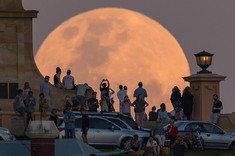Update for Jan. 31: For full coverage and live views of the Super Blue Blood Moon eclipse of 2018, visit our main guide here: Super Blue Blood Moon 2018: Complete Lunar Eclipse Coverage!
When the “Full Wolf Moon” rises on Monday, Jan. 1, it will also be the first of two “supermoons” in 2018, both of them in January.
New Year’s Day Full Moon: Are ‘Supermoons’ Really That Super?
Full Wolf Moon: New Year’s Supermoon Is the Biggest of the Year
The moon becomes full at 9:24 p.m. EST (0224 GMT Tuesday Jan. 2). That peak comes hours after the moon reaches perigee, its closest point to Earth for the month, at 4:54 p.m. EST (2154 GMT). At that time, according to EarthSky.org , the moon will be about 221,559 miles (356,565 kilometers) from Earth. [Supermoon Secrets: 7 Surprising Big Moon Facts ]
January’s supermoon is actually the second of three back-to-back supermoon full moons to come in the next two months. The full moon also occurred near perigee on Dec. 3 and will again on Jan. 31, according to NASA, which billed the line up as a supermoon trilogy . The Jan. 31 supermoon is also the second full moon of January, making it a blue moon , and also occurs during a total lunar eclipse .
Supermoon 2017! Amazing Full Cold Moon Photos by Stargazers
What is a supermoon?
Supermoons happen when a full moon approximately coincides with the moon’s perigee, or a point in its orbit at which it is closest to Earth. This makes the moon appear up to 14 percent larger and 30 percent brighter than usual.
While the moon’s average distance is 238,000 miles (382,900 km) from Earth, its orbit isn’t perfectly circular, so that distance varies a small amount. The perigee for January’s supermoon is the closest of this year.
 Learn what makes a big full moon a true ‘supermoon’ in this Space.com infographic
.” data-options-closecontrol=”true” data-options-fullsize=”true”/>
Learn what makes a big full moon a true ‘supermoon’ in this Space.com infographic
.” data-options-closecontrol=”true” data-options-fullsize=”true”/>Credit: Karl Tate/SPACE.com
Supermoons don’t happen every month because the moon’s orbit changes orientation as the Earth goes around the sun. So, the long axis of the moon’s elliptical path around the Earth points in different directions, meaning that a full (or new) moon won’t always happen at apogee or perigee.
When to see the supermoon
The first supermoon of 2018 peaks at 9:24 p.m. EST (0224 GMT Tuesday Jan. 2). For observers in New York City, the moon will rise in the east-northeastern sky at 4:34 p.m. EST and stay up through the night, setting the morning of Jan. 2 at 7:36 a.m. EST, according to timeanddate.com . Look for the moon in or near the constellation Gemini.
While the moon is officially full on Jan. 1, it will still appear full to the casual observer the night before and after.
The second supermoon of January will occur on Jan. 30 and 31. The moon will reach perigee at 4:54 a.m. EST (0954 GMT) on Jan. 30, at a distance of 223,069 miles (358,995 km) from Earth, according to EarthSky.org. Then, on Jan. 31, the moon reaches its full phase at 8:27 a.m. EST (1327 GMT) coincides with a total lunar eclipse. NASA has billed the Jan. 31 moon a “super blue blood moon” despite the gap between the moon’s arrival at perigee and its peak full phase.
How the Full Wolf Moon got its names
According to the Old Farmer’s Almanac, the name of the full moon in January is the “Full Wolf Moon” and dates back to Native American tribes and early Colonial times when wolves would howl outside villages. It is also known as the Old Moon, Moon after Yule and the Snow Moon.
That last moniker, the Full Snow Moon, is typically applied to the February full moon, though since there are two full moons in January, there will be no full moons in February, according to the Old Farmer’s Almanac.
Editor’s note: If you captured an amazing photo of video of January supermoons or Jan. 31 total lunar eclipse and would like to share it with Space.com for a story or gallery, send images and comments to: spacephotos@space.com.

0 of 10 questions complete
You can follow SPACE.com on Twitter @Spacedotcom . We’re also on Facebook & Google+ .

Comments are closed.